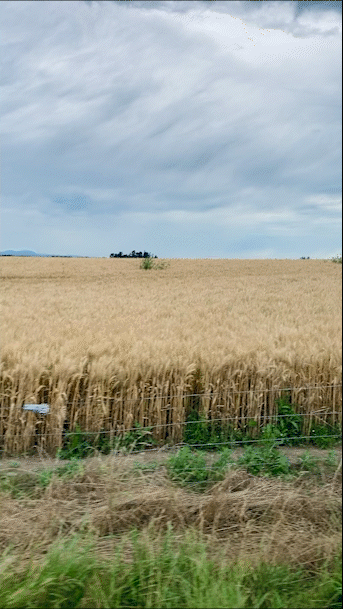FERTILE SOIL
On Wednesday 2nd February Sam had the privilege of joining some of New Zealand's best bakers on a field trip to the arable lands of Canterbury. Read on to follow the story of New Zealand's wheat industry.
There really is nothing like standing in the middle of a Canterbury wheat field. The nor’ west wind catches the awn of every head of wheat and pushes and leans on the crop. The wheat heads arch over, slightly bowed, straining to stand up and hold on for another few weeks until harvest. On this farm today, what starts as 22 hectares of bare land in autumn will become 200 odd tonnes of grain at the end of summer. That 200 tonnes of raw grain gets milled and sieved to become 140+ tonnes of flour. That flour will be turned into over 300,000 loaves of bread. It’s all very humbling to imagine.
I’m here today with a collection of bakers to talk shop and contemplate the future of New Zealand grain. Shelly Bay Baker from Wellington, The Dusty Apron from Auckland, The Real Bread Project from Helensville, Blue House Bakery from Lyttelton, Bacca Bakery from Parapara and Grizzly are assembled here under the guidance of Angela Clifford (Eat New Zealand, The Food Farm).
Dusty in his element
We start our day in Templeton with Ivan Lawrie from the Foundation for Arable Research (FAR). FAR is involved with the funding of seed, grain and cereal silage research and technology transfer. They are in part funded via a levy on all grains and seeds produced by the farmers. Ivan gives us a quick run down on the current state of New Zealand wheat.
Did you know:
The majority of wheat in New Zealand is grown as feed wheat for livestock?
The vast majority of bread and flour produced in the North Island is from Australian wheat?
I wonder how many people know that their flour comes from across the ditch. We’re a farming nation so we could be mistaken for assuming that all our flour, dairy and meat might be locally grown and raised, but it’s sadly not the case.
Minchins Road
With thoughts already swirling we drive out to Marty Skurr’s farm in Sheffield. Marty is a 4th generation arable farmer here in Canterbury and wheat is in his blood. His farm rotates paddocks through wheat, barley, seed crops, and grazing every year. Arable farming is an enormously risky business. You plan all year for the harvest to come and one ill-timed batch of rainfall can seriously compromise a crop. A wind could bring disease or pests from a farm many miles away. Two years ago Marty’s milling wheat crop was a dud. If wheat is in his blood then so is resilience.
We walk through his wheat field and come upon a several blocks of trial wheats being grown for FAR. Farmers contribute a portion of their paddocks each year for research and development. Among the 18 small blocks of trial grains the variety is evident. Some have long bristly awns like hedgehog spikes and some have none at all. Some are closer to harvest than others, bent over like a walking cane. Some are stiff and upright, their stalks still green and many weeks from maturity.
Trial blocks of wheat
Marty’s 22ha of wheat will be ready in 2-3 weeks. Harvest is a difficult thing to predict. Ideally you do it at the nexus point of crop maturity, moisture content, and sunny days but the weather system like the one looming later this week can play havoc on these predictions.
As we move inside Marty’s shed we are greeted by his flour milling setup. He sells his stoneground wheat under the brand Minchins Milling (the farm straddles two sides of Minchins Road so the name is a signifier of localism). Marty is investing in a larger setup for his milling operation. Roller-mills will crack the grain into smaller pieces before being ground into flour between two hefty stone disks.
Marty surveys his milling setup
Marty believes in the quality of New Zealand grains and the preciousness of local food. He knows he could get paid more for growing feed wheat, an absurd reality that warrants a second look.
The Food Farm
If you press a head of wheat between your palms and grind it firmly you will seperate the wheat from the protective layer of chaff. Gently blown upon by the Canterbury wind, the chaff will fly off into the breeze leaving you with the grain you so desired. At the bakers roundtable on the Food Farm, Angela Clifford had much the same desire.
She fed us heartily with wood-fired pizza and plied us with a glass (or two) of North Canterbury pét-nat rosé until our guard was down. We were then asked to imagine what the New Zealand grain, milling, and baking industries could look like in 10 years time.
Sam and Simon from Shelly Bay/Capital Millers, Angela from Eat New Zealand/The Food Farm










